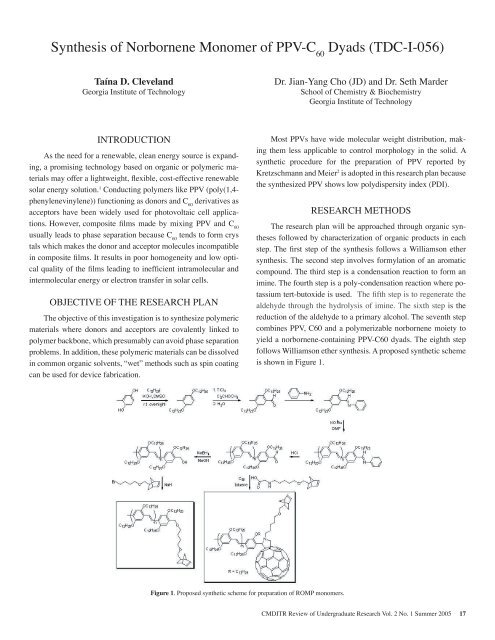Student Project Abstracts 2005 - Pluto - University of Washington
Student Project Abstracts 2005 - Pluto - University of Washington
Student Project Abstracts 2005 - Pluto - University of Washington
Create successful ePaper yourself
Turn your PDF publications into a flip-book with our unique Google optimized e-Paper software.
Synthesis <strong>of</strong> Norbornene Monomer <strong>of</strong> PPV-C 60Dyads (TDC-I-056)Taína D. ClevelandGeorgia Institute <strong>of</strong> TechnologyDr. Jian-Yang Cho (JD) and Dr. Seth MarderSchool <strong>of</strong> Chemistry & BiochemistryGeorgia Institute <strong>of</strong> TechnologyINTRODUCTIONAs the need for a renewable, clean energy source is expanding,a promising technology based on organic or polymeric materialsmay <strong>of</strong>fer a lightweight, flexible, cost-effective renewablesolar energy solution. 1 Conducting polymers like PPV (poly(1,4-phenylenevinylene)) functioning as donors and C 60derivatives asacceptors have been widely used for photovoltaic cell applications.However, composite films made by mixing PPV and C 60usually leads to phase separation because C 60tends to form crystals which makes the donor and acceptor molecules incompatiblein composite films. It results in poor homogeneity and low opticalquality <strong>of</strong> the films leading to inefficient intramolecular andintermolecular energy or electron transfer in solar cells.OBJECTIVE OF THE RESEARCH PLANThe objective <strong>of</strong> this investigation is to synthesize polymericmaterials where donors and acceptors are covalently linked topolymer backbone, which presumably can avoid phase separationproblems. In addition, these polymeric materials can be dissolvedin common organic solvents, “wet” methods such as spin coatingcan be used for device fabrication.Most PPVs have wide molecular weight distribution, makingthem less applicable to control morphology in the solid. Asynthetic procedure for the preparation <strong>of</strong> PPV reported byKretzschmann and Meier 2 is adopted in this research plan becausethe synthesized PPV shows low polydispersity index (PDI).RESEARCH METHODSThe research plan will be approached through organic synthesesfollowed by characterization <strong>of</strong> organic products in eachstep. The first step <strong>of</strong> the synthesis follows a Williamson ethersynthesis. The second step involves formylation <strong>of</strong> an aromaticcompound. The third step is a condensation reaction to form animine. The fourth step is a poly-condensation reaction where potassiumtert-butoxide is used. The fifth step is to regenerate thealdehyde through the hydrolysis <strong>of</strong> imine. The sixth step is thereduction <strong>of</strong> the aldehyde to a primary alcohol. The seventh stepcombines PPV, C60 and a polymerizable norbornene moiety toyield a norbornene-containing PPV-C60 dyads. The eighth stepfollows Williamson ether synthesis. A proposed synthetic schemeis shown in Figure 1.Figure 1. Proposed synthetic scheme for preparation <strong>of</strong> ROMP monomers.CMDITR Review <strong>of</strong> Undergraduate Research Vol. 2 No. 1 Summer <strong>2005</strong> 17




